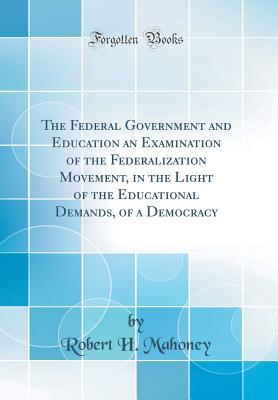Download The Federal Government and Education an Examination of the Federalization Movement, in the Light of the Educational Demands, of a Democracy (Classic Reprint) - Robert H Mahoney | ePub
Related searches:
The Roles of Federal and State Governments in Education - FindLaw
The Federal Government and Education an Examination of the Federalization Movement, in the Light of the Educational Demands, of a Democracy (Classic Reprint)
ESEA and Federal Education Policy in the 1960s - JSTOR
Effects of the Federal Role and Intervention in Education
The Basic Structure of the U.S. Federal Government
The Role Of The Federal Government In The US Education System
22 Pros and Cons of Federal Involvement in Education
Education Downsizing the Federal Government
The Federal Government Gives Native Students an Inadequate
Feds in the Classroom: How Big Government Corrupts - Amazon.com
Expand the Federal Role in Education RealClearEducation
The Federal Government's Role in Education: School Vouchers
College and Higher Education USAGov
Why the Federal Government Should Get Out of Education - The
Federal Education Funding: Where Does the Money Go? Data
Within the constitution, the responsibility of education resides with the states. But because there is a pressing national interest to provide high-quality education for our youth, the federal government has historically provided funds to supplement state and district budgets.
Government is designed with three branches that have separate but related powers. How would you create a government from scratch? the structure of the united states govern.
The department of education operates a range of aid programs for elementary and secondary schools.
Mar 27, 2015 it's time for people on all sides of the debate to admit that if not for the federal government, most of america's schools would still be in the 1950s.
The three powers given to the federal government are legislative, executive and judicial. The legislative branch, which comprises the senate and the house the three powers given to the federal government are legislative, executive and judic.
Department of education is the agency of the federal government that establishes policy for, administers and coordinates most.
Federal aid to public education simply reinforces a socialist, government owned and operated education system which distorts market values and encourages monopoly union practices.
A persistent debate that the united states has struggled with since its early history is the role of the federal government in the education of its citizenry.
With the institution of common core standards, federal involvement in education helped to provide more consistency in mathematics, reading, social students, and other essential subjects.
Find federal education legislation, regulations, guidance, and other policy documents. Go data� explore and download data and learn about education-related data.
The federal role in education has created an enormous compliance burden for states and local schools. Some of this can be quantified in terms of paperwork, time, and resources.
The most expensive programs are social security, defense, and medicare.
Education plays a direct role in the lives of all citizens both directly and indirectly. Hence the education policies and objectives that are laid out by the federal government should be one that ensures that the there is no lapse when it comes to framing the right policy as far as education is concerned.
Unlike the systems of most other countries, education in the united states is highly decentralized, and the federal government and department of education are not heavily involved in determining curricula or educational standards (with the exception of the no child left behind act).
The federal government also influences education by allocating funding only to those school districts that follow certain federal guidelines. Roughly three percent of the federal budget is spent on education as of 2017 - a small proportion, of course, but in many years this amounts to billions of dollars.
Education has long been considered a national concern by the federal government. Through federal action, education has been encouraged and financially supported from the first northwest ordinance in 1787 to the present.
The elementary and secondary education act (esea) of 1965 was a key part of lyndon johnson’s war on poverty and has set the basic terms of the federal government’s involvement in education ever since. Rather than mandating direct federal oversight of schools, esea offered states funding for education programs on a conditional basis.
Aug 6, 2020 years after the policy ended, the federal government transformed the school system into the bureau of indian education.
Historically, education has been a local matter; however, the federal government has found a persuasive way to become involved, namely, by offering large amounts of money to those states and school districts which implement federal initiatives.
As for the federal government’s role, education is not specifically addressed in the constitution, but a historical precedent of central government involvement does exist.
Mar 23, 2020 this is an unprecedented crisis for our education system, which will be heightened further by the looming economic downturn.
Veterans and military service members - you may qualify for education benefits. There are many education programs for past and present service members and their families. Student loans - learn about federal and private student loans.
Since federal grants to the states may be conditioned upon the state's adoption of certain legal and regulatory structures, the federal government has been able.

Post Your Comments: